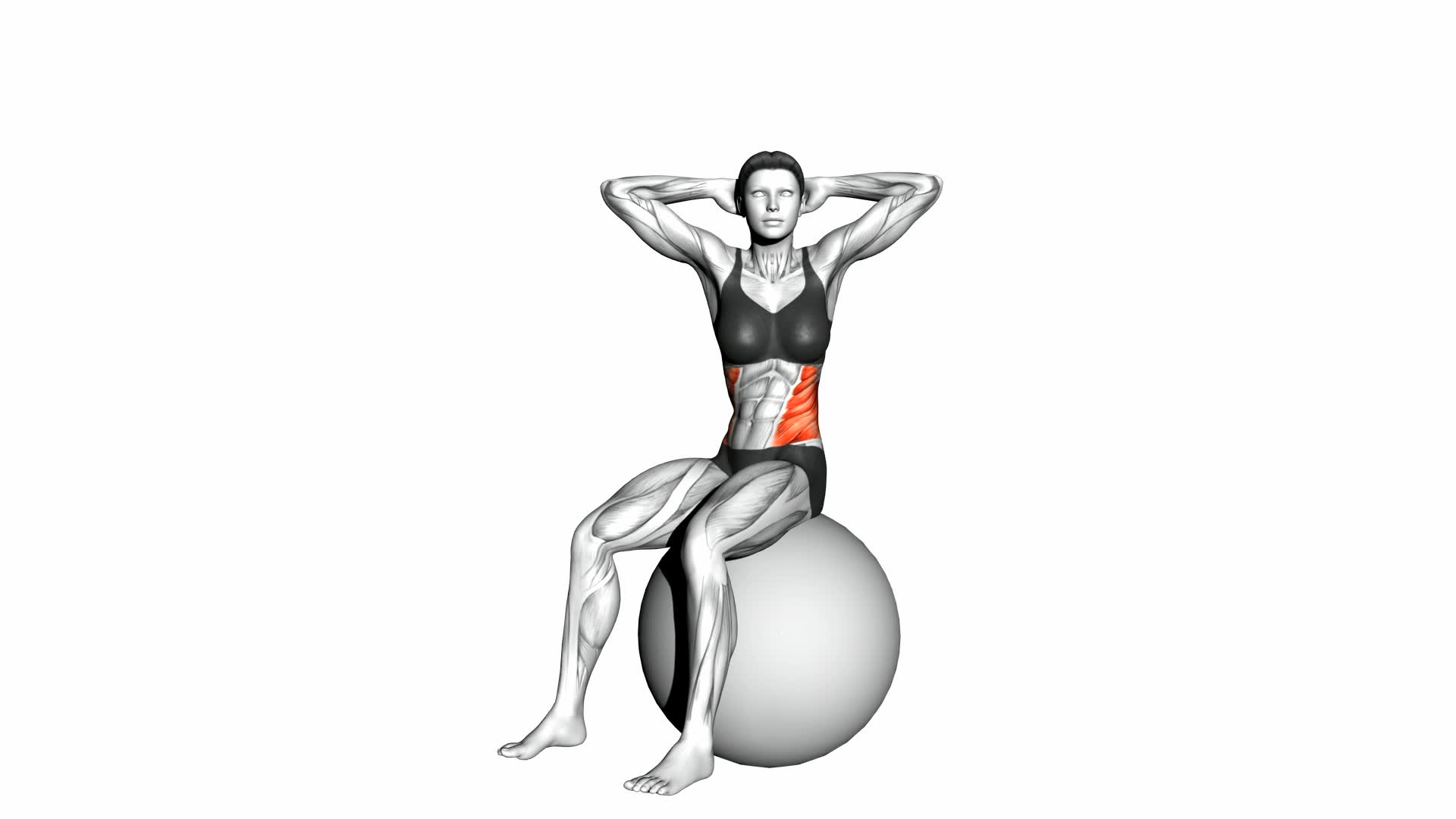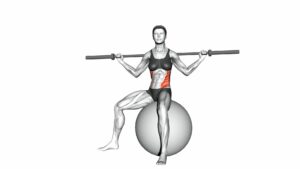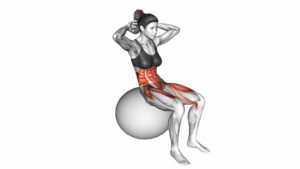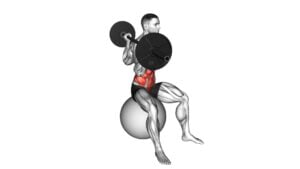Seated Twist (On Stability Ball) – Video Exercise Guide & Tips

Get ready to strengthen your core and increase flexibility with the Seated Twist on a Stability Ball.
Watch This Exercise Video
This video exercise guide will walk you through the proper form and technique, as well as provide helpful tips to maximize your results.
Don't let common mistakes hinder your progress – learn how to avoid them and get the most out of this effective exercise.
Grab your stability ball and let's twist!
Key Takeaways
- The seated twist on a stability ball improves spinal mobility and engages core muscles for increased stability and strength.
- This exercise targets muscles of the back, abdomen, and obliques, promoting better flexibility and range of motion.
- It can help alleviate lower back pain and should be performed with proper form and technique to avoid strain.
- To maximize the effectiveness of the seated twist, maintain proper alignment, avoid over-rotation, and focus on deep breathing.
Benefits of the Seated Twist on a Stability Ball
Experience the incredible benefits of performing the Seated Twist on a Stability Ball. This exercise isn't only enjoyable but also highly effective in improving spinal mobility and core strengthening. By incorporating the stability ball into your seated twist, you engage your core muscles even more, leading to increased stability and strength.
The Seated Twist on a Stability Ball targets the muscles of your back, abdomen, and obliques. As you rotate your torso side to side, the movement helps to stretch and lengthen the muscles along your spine, promoting better flexibility and range of motion. This is particularly beneficial for individuals who spend long hours sitting or have sedentary lifestyles, as it counteracts the effects of prolonged sitting and helps alleviate lower back pain.
Furthermore, the instability of the stability ball forces your core muscles to work harder to maintain balance during the exercise. This not only strengthens your core but also improves your overall stability and posture. As you continue to practice the Seated Twist on a Stability Ball, you'll notice increased core strength, improved spinal mobility, and enhanced body awareness.
Incorporating the Seated Twist on a Stability Ball into your fitness routine can provide numerous benefits, including improved spinal mobility and core strengthening. So grab a stability ball and start experiencing the incredible benefits of this exercise today.
Proper Form and Technique for the Seated Twist
To perform the Seated Twist on a Stability Ball with proper form and technique, you need to maintain a stable base while engaging your core muscles. Start by sitting on the stability ball with your feet planted firmly on the ground. Keep your spine straight and your shoulders relaxed. Place your hands on the sides of your head or cross your arms over your chest.
From this position, gently twist your torso to one side, rotating from your waist. Make sure to keep your hips stable and your feet firmly planted as you twist. Return to the starting position and then twist to the other side. Repeat this movement for the desired number of repetitions.
There are variations and modifications for the Seated Twist that you can try to add variety to your workout routine. One variation is to hold a dumbbell or medicine ball in front of your chest while performing the twist. This adds resistance and increases the challenge for your core muscles.
Another modification is to perform the twist with your feet lifted off the ground, balancing on the stability ball. This requires more stability and engages your core even further. Remember to listen to your body and choose the variation or modification that's appropriate for your fitness level.
Proper form and technique are key to getting the most out of the Seated Twist exercise and preventing injury.
Equipment Needed for the Seated Twist Exercise
You will need some equipment for the Seated Twist exercise. Here are three essential items that will help you perform this exercise effectively:
- Stability ball: This exercise requires a stability ball, also known as a Swiss ball or exercise ball. Choose a stability ball that's the right size for your height. The stability ball will provide an unstable surface, which will engage your core muscles and improve your balance during the exercise.
- Comfortable clothing: Wear comfortable clothing that allows for a full range of motion. Choose breathable materials that wick away sweat to keep you comfortable throughout the exercise.
- Exercise mat: It's recommended to use an exercise mat to provide cushioning and stability for your feet during the Seated Twist exercise. The mat will also protect your knees and provide a non-slip surface.
Having the right equipment is essential for performing the Seated Twist exercise correctly and safely. The stability ball will challenge your core strength and stability, while comfortable clothing and an exercise mat will enhance your overall comfort and safety during the exercise.
Common Mistakes to Avoid During the Seated Twist
When performing the Seated Twist on a stability ball, it's important to be aware of common mistakes to avoid. One common mistake is improper alignment. Make sure to sit tall on the stability ball with your feet flat on the ground and your knees at a 90-degree angle. This will help maintain proper alignment of your spine and pelvis throughout the exercise.
Another mistake to avoid is twisting too far. While it may be tempting to twist as far as possible, over-rotation can strain your back and neck. Instead, focus on twisting from your core while keeping your chest lifted and your shoulders relaxed.
Additionally, be mindful of your breathing. Many people hold their breath or take shallow breaths during the seated twist, which can limit the effectiveness of the exercise. Remember to inhale deeply as you prepare to twist and exhale slowly as you rotate.
Tips to Maximize the Effectiveness of the Seated Twist
To maximize the effectiveness of the Seated Twist, incorporate a variety of resistance levels using different stability balls. This will challenge your core muscles in different ways and help you achieve better results.
Here are some tips to help you get the most out of your Seated Twist:
- Try seated twist modifications: If you find it difficult to maintain your balance on the stability ball, you can perform the seated twist on a stable surface such as a bench or chair. This modification allows you to focus on the twisting motion without worrying about stability.
- Use proper form: Make sure to maintain a tall and upright posture throughout the exercise. Keep your core engaged and your shoulders relaxed. Avoid hunching forward or rounding your back, as this can put unnecessary strain on your spine.
- Find the best time to perform the seated twist: The seated twist can be done as part of your warm-up routine or as a standalone exercise. Experiment with different times of the day to see when your body feels most comfortable and ready to twist.
Incorporating these tips into your Seated Twist routine will help you maximize its effectiveness and ensure that you're getting the most out of this exercise. Remember to listen to your body and adjust the resistance level and modifications as needed.
Frequently Asked Questions
How Many Calories Does the Seated Twist on a Stability Ball Burn?
The seated twist on a stability ball can help you burn calories and improve your posture. By engaging your core muscles and twisting your torso, you can increase your heart rate and boost your calorie burn.
This exercise also helps strengthen your back and abdominal muscles, leading to better posture.
Can the Seated Twist on a Stability Ball Help Improve Posture?
The seated twist on a stability ball can definitely help improve your posture. By engaging your core muscles and increasing flexibility, this exercise helps to strengthen the muscles that support your spine, promoting better alignment and posture.
Regularly incorporating the seated twist into your workout routine can lead to improved posture over time. So, if you're looking to stand tall and confident, give this exercise a try!
Is It Safe to Perform the Seated Twist on a Stability Ball if I Have Lower Back Pain?
If you have lower back pain, it may not be safe to perform the seated twist on a stability ball. It's important to listen to your body and avoid any movements that worsen your pain.
There are modifications you can try, such as doing the seated twist on a chair or using a smaller range of motion. Additionally, there are alternative exercises that can provide relief for lower back pain, like gentle stretches or exercises that focus on strengthening the core muscles.
How Often Should I Do the Seated Twist on a Stability Ball to See Results?
To see results from the seated twist on a stability ball, you need to do it regularly. The frequency of your seated twist sessions will play a role in how quickly you see results. By incorporating the seated twist into your workout routine a few times a week, you can start reaping its benefits.
It's a great exercise for improving core strength, flexibility, and posture. So, make sure to include it in your fitness regimen!
Can the Seated Twist on a Stability Ball Be Modified for Beginners or Those With Limited Mobility?
Modified variations of the seated twist on a stability ball can be beneficial for beginners or those with limited mobility. These alternatives allow you to still engage your core and work on spinal mobility, but with less intensity.
Some options include performing the twist while seated on a bench or chair, using a smaller stability ball, or reducing the range of motion. These modifications can help you gradually build strength and flexibility while minimizing strain on your body.
Conclusion
In conclusion, the seated twist on a stability ball is a beneficial exercise for improving core strength and flexibility.
It's important to maintain proper form and technique to avoid injury. The only equipment needed is a stability ball.
Avoid common mistakes such as using momentum and twisting too far. To maximize the effectiveness of the exercise, engage the core muscles and perform the movement slowly and controlled.

Author
Years ago, the spark of my life’s passion ignited in my mind the moment I stepped into the local gym for the first time. The inaugural bead of perspiration, the initial endeavor, the very first surge of endorphins, and a sense of pride that washed over me post-workout marked the beginning of my deep-seated interest in strength sports, fitness, and sports nutrition. This very curiosity blossomed rapidly into a profound fascination, propelling me to earn a Master’s degree in Physical Education from the Academy of Physical Education in Krakow, followed by a Sports Manager diploma from the Jagiellonian University. My journey of growth led me to gain more specialized qualifications, such as being a certified personal trainer with a focus on sports dietetics, a lifeguard, and an instructor for wellness and corrective gymnastics. Theoretical knowledge paired seamlessly with practical experience, reinforcing my belief that the transformation of individuals under my guidance was also a reflection of my personal growth. This belief holds true even today. Each day, I strive to push the boundaries and explore new realms. These realms gently elevate me to greater heights. The unique combination of passion for my field and the continuous quest for growth fuels my drive to break new ground.







